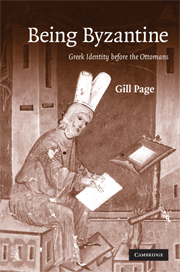Book contents
- Frontmatter
- Contents
- List of illustrations
- Acknowledgements
- A note on the use and transliteration of Greek
- Abbreviations
- Reference works
- Introduction: The Frankish conquest of Greece
- 1 Ethnic identity?
- 2 Byzantine identities
- 3 Niketas Choniates
- 4 The thirteenth century: ambition, euphoria and the loss of illusion
- 5 The nightmare of the fourteenth century
- 6 Meanwhile, a long way from Constantinople …
- 7 The long defeat
- 8 Roman identity and the response to the Franks
- Glossary
- Map 1 The Aegean region
- Map 2 The Peloponnese
- Appendix 1 Key content items
- Appendix 2 The origins of the Chronicle of the Morea
- Bibliography
- Index
5 - The nightmare of the fourteenth century
Published online by Cambridge University Press: 24 November 2009
- Frontmatter
- Contents
- List of illustrations
- Acknowledgements
- A note on the use and transliteration of Greek
- Abbreviations
- Reference works
- Introduction: The Frankish conquest of Greece
- 1 Ethnic identity?
- 2 Byzantine identities
- 3 Niketas Choniates
- 4 The thirteenth century: ambition, euphoria and the loss of illusion
- 5 The nightmare of the fourteenth century
- 6 Meanwhile, a long way from Constantinople …
- 7 The long defeat
- 8 Roman identity and the response to the Franks
- Glossary
- Map 1 The Aegean region
- Map 2 The Peloponnese
- Appendix 1 Key content items
- Appendix 2 The origins of the Chronicle of the Morea
- Bibliography
- Index
Summary
It is hard to express the debilitated misery of the Byzantine Roman empire in the fourteenth century – a period of repeated civil war, religious hatred and foreign invasions. It is now necessary to trace the course of that century, an age of decline for the empire of the Romans to such an extent that by the end of the century it had become a tributary state of the Ottomans. How did things get so bad?
At the end of the discussion on Akropolites and Pachymeres, we left the empire of the Byzantine Romans under the rule of Andronikos II Palaiologos: Constantinople had been regained by Andronikos’ father Michael VIII, who had also neutralised the western threat of the Angevins; however, Michael had also stirred up a great deal of unhelpful religious fervour and, as the new century dawned, the Ottomans and the Catalans had presented fresh threats.
After the disasters against the Ottomans and the Catalans, the second decade of the fourteenth century onwards was a period of stabilisation under Andronikos II. The treasury was brought back to health, although at the expense of substantial military cutbacks. Epiros and Thessaly were inching back into the imperial fold while, in the Peloponnese, Byzantine Roman power was growing at the expense of the Frankish principality, which was torn between rival claimants. However, in 1320 the untimely death of the heir presumptive Michael IX Palaiologos, son of Andronikos II, precipitated a crisis.
- Type
- Chapter
- Information
- Being ByzantineGreek Identity Before the Ottomans, 1200–1420, pp. 138 - 176Publisher: Cambridge University PressPrint publication year: 2008



